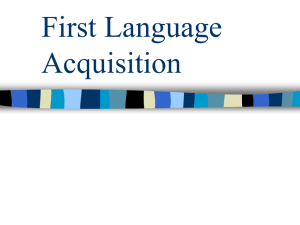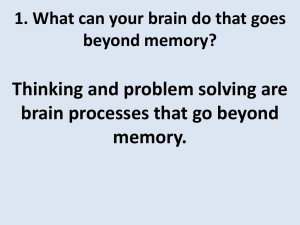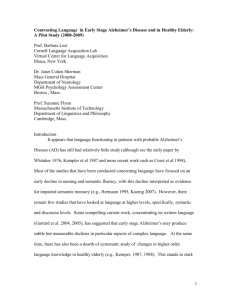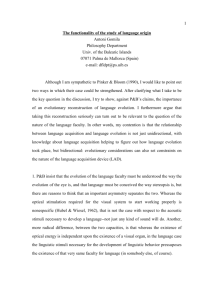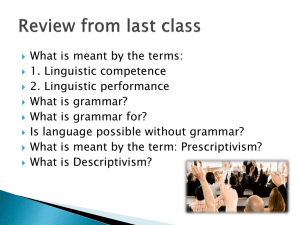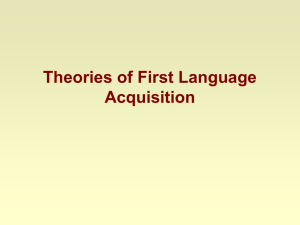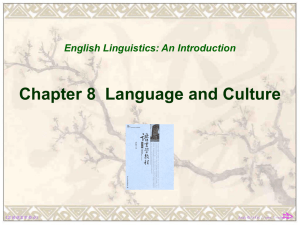ELT
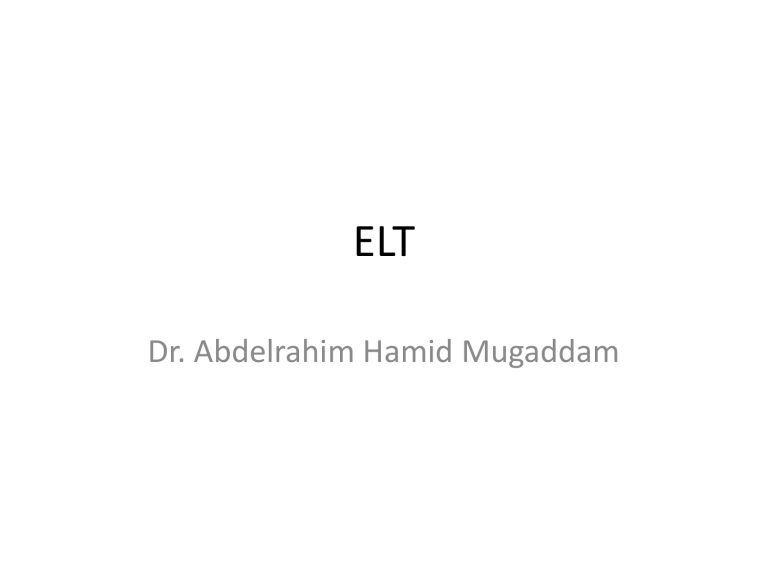
ELT
Dr. Abdelrahim Hamid Mugaddam
Theories of First language acquisition
•
Behavioristic approach
• Language is a fundamental part of total human behavior
• Focus : the immediately perceptible aspects of linguistic behavior- the publicly observable responses + the relationships or associations between those responses and events in the world surrounding them
• Effective language behaviour to be the production of correct responses to stimuli… if a particular response is reinforced , it then becomes habitual , or conditioned.
• Thus children produce linguistic responses that are reinforced
• One learns to comprehend an utterance by responding appropriately to it and by being reinforced for that response
• Skinner (1957) , verbal behavior . .. An extention of his general theory of learning by operant conditioningh. Operant conditioning refers to conditioning in which the organism (human being), emits a response, or operant (a sentence or utterance). Without necessarily observable stimuli; the operant is maintained (learned) by reinforcement (for example , a positive verbal or nonverbal response from another person)
• If a child says “want milk” and a parent gives milk the operant is reinforced and, over repeated instances, is conditioned
• According to Skinner, verbal behavior , like other behavior is controlled by its consequences . When consequences are rewarding, behavior is maintained and is increased in strength and perhaps frequency. When consequences are punishing, or when there is a total lack of reinforcement, the behavior is weakened and eventually extinguished.
• Heavily criticized by Chomsky (1959)
• Defended by Kennth Macorquodale
• Today, virtually no one would agree that skinner’s model of verbal behavior adequately accounts for the capacity to acquire language for language development itself, for the abstract nature of language and , or for a theory of meaning
.
The Nativist approach
• the term nativist is derived from the fundamental assertion that language acquisition is innately determined.
• That we are born with a genetic capacity that predisposes us to systematic perception of language around us , resulting in the construction of an internalized system of language
•
Support!; Lennneberg (1967): Language is
‘species-specific’ behavior and that certain modes of perception, categorizing abilities and other language- related mechanisms are biologically determined.
• Support2: Chomscky; the existence of innate properties of language to explain the child’s mastery of a native language in such a short time despite the highly abstract nature of the rules of language.
• The innate knowledge is embodied in a “little black box”.. Language acquisition Device (LAD)
• MC Neil (1966) described LAD as:
1. The ability to distinguish speech sounds from other sounds in the environment
2. The ability to organize linguistic data into various classes that can later be refined
3. Knowledge that only a certain kind of linguistic system is possible and that others are not
4. The ability to engage in constant evaluation of the developing linguistic system so as to construct the simplest possible system out of the available linguistic input.
Functional Approach
• Recent shift in pattern of research: from the form of language to the essence of language…2 emphases
1.
Language as one manifestation of the cognitive and affective ability to deal with the world
2.
Generative rules are abstract, formal, quite logical, explicit, yet they dealt specifically with the forms of language not the deeper functional levels of meaning constructed from social interaction.
• Form: morphemes , words, sentences, words, and the rules that govern them
• Functions: the meaningful, interactive purposes, within a social (pragmatic) context, that we accomplish with forms.
Functional approach continue…
Cognition and Language Development
• Research in child language focuses on the relationship of cognitive development to first language situation
• Piaget (1969) described overall development as the result of children ‘s interaction with their environment, with a complementary interaction between their developing perceptual cognitive capacities and language experience.
• What children learn about language is determined by what they already know about the world.
Functional approach continue
Social interaction and language development
In recent years it becomes evident that language functioning extends well beyond cognitive thought and memory structure.
• Holzman (1984) : reciprocal model of language development: “ a reciprocal behavior al system operates between the language developing infant and the competent (adult) language user in a socializingteaching-nurturing role child’s ”
• Gleason (1988) looked at the interaction between the child’s language acquisition and the learning of how social system operate in human behavior
• Others (Budwig 1995, Kuczaj 1984): the function of language in discourse: what do children know and learn about talking with others? About connected pieces of discourse? Conversational cues?
